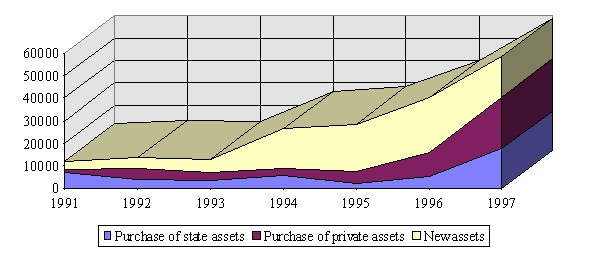| 1998 report on foreign investment in Latin America and the Caribbean THE PURCHASE OF EXISTING ASSETS
DRIVES FOREIGN DIRECT INVESTMENT IN LATIN AMERICA
- mergers and
acquisitions are now predominant, says ECLAC report -
The purchase of existing assets,
rather than the creation of new ones, is now the main form of foreign direct investment
(FDI) in Latin America, reports ECLAC in the 1998 edition of its annual study, Foreign
Investment in Latin America and the Caribbean.
This conclusion is based on figures
for the eleven countries grouped in the Latin American Integration Association (ALADI),
including the region’s main FDI recipients. While full information does not exist on
the classification of foreign investments by new or purchased assets, an educated
approximation can be made by comparing available information on mergers, acquisitions and
privatizations with total FDI. While this somewhat exaggerates the sale of existing
assets, by assuming that the value of those assets is registered as FDI in the balance of
payments for the same year as the operation, it provides interesting insight into the
changing nature of foreign investment flows in Latin America.
FDI to these eleven Latin American
countries really took off in 1994, when it passed the US$25,000 million mark. Until 1996,
the principal modality of such investment was the creation of new assets. Subsequently,
however, the purchase of private assets by way of mergers and acquisitions increased
substantially, to become the principal modality of FDI in the region by 1997. The purchase
of state assets through privatization operations also increased considerably in 1997, more
than tripling the figure for 1996. Privatisations and the creation of new assets accounted
for similar amounts of FDI, US$17,328 million and US$17,810 million, respectively, while
the purchase of private assets achieved a class of its own: US$23,362 million.
FDI Modalities in 11 Latin
American Countries, 1991-1997: an approximation
(millions of dollars)

The latter modality has been used
mainly in Brazil (banking, food, beverage and tobacco products and chemicals), Mexico
(banking, and food, beverage and tobacco products), Argentina (banking and food, beverage
and tobacco products), and Chile (banking). The privatization of state assets has been
concentrated in Brazil (telecommunications, electricity generation and distribution),
Venezuela (new concessions for petroleum exploration and extraction), Colombia
(electricity generation and distribution) and Chile (electricity generation and
distribution).
Two major concerns arise as a result
of this relative decline in the creation of new assets as the principal mode of FDI in
Latin America. The sale of national property to foreigners does not necessarily result in
new, more modern or more competitive goods and services, despite the fact that these sales
often involve associated investment by the new owners; instead, strategic considerations
by global oligopolies are often the main consideration. And, at some point the State will
run out of assets to privatize, creating the danger of a drastic decline in FDI and
consequent balance-of-payments instability in host country.
Back to summaries |